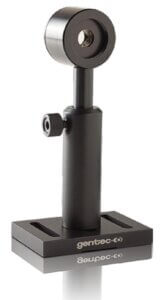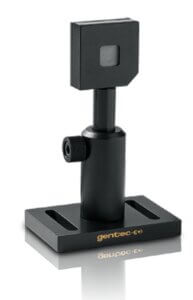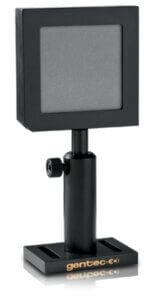Energy Detectors
The Gentec EO’s pyroelectric energy detectors offered by Laser Lines cover a wide energy band, ranging from ultra low energy nano-joules levels, right up to high energy levels, of multiple joules per pulse. They also come in a wide variety of sizes, ranging from 8mm in diameter, right up to 95mm – and most of them are available with an optional attenuator. Laser Lines can also supply a wider range of accessories with all of the detectors, making them easy to setup and use.
• Wide range of detectors to cover a host of different energy levels
• Available with a useful set of practical accessories including stands, connectors, adaptors and storage cases etc.
• Backed up with useful easy to follow technical documentation
• Available in a wide variety of detector sizes
• Compatible with Maestro, M-Link and S-Link monitors
 The comprehensive range includes the QE-B, QE12, QE15, QE25, QE50, QE65 and QE95 detectors, please contact Laser Liones for further information and advice.
The comprehensive range includes the QE-B, QE12, QE15, QE25, QE50, QE65 and QE95 detectors, please contact Laser Liones for further information and advice.
QE-B
Consisting of small compact detectors (8mm diameter aperture). Very low noise levels as low as 50nJ, but with the high energies of a pyroelectric. Organic black or metallic coatings with spectral ranges from DUV to Far-IR
 QE12 and QE25 Energy Detector
QE12 and QE25 Energy Detector
Offering low noise levels, you can increase the power capability of your QE25 energy detectors, with 2 different cooling modules. Available with optional calibration you can measure up to 5X higher energies on all wavelengths between 532 and 1064nm, or a single wavelength. QED attenuator is also available.
 QE50 Energy Detector
QE50 Energy Detector
Physically larger detector but with a similar modular design concept, low noise levels and power capability to the QE25 detectors (ability to measure up to 5X higher energies), the QE50 energy detector has high repetition rate options.
QE65 and QE95 Energy Detectors
With effective apertures of 65 x65mm and 95mm diameter, respectively.
QED Attenuator
The QED attenuators increase the energy, energy density, average power and average power density capabilities of the QE Series detectors. They are engineered to typically transmit 30-50% (@1.064 µm) of the incident radiation to the detector in a near Lambertian pattern (which is a very wide diffusion pattern). Their slide-in casing make them easy to install and remove and they are held securely in place with the use of simple set screws. Since they become part of the detector, it is important to understand how they will affect the calibration
